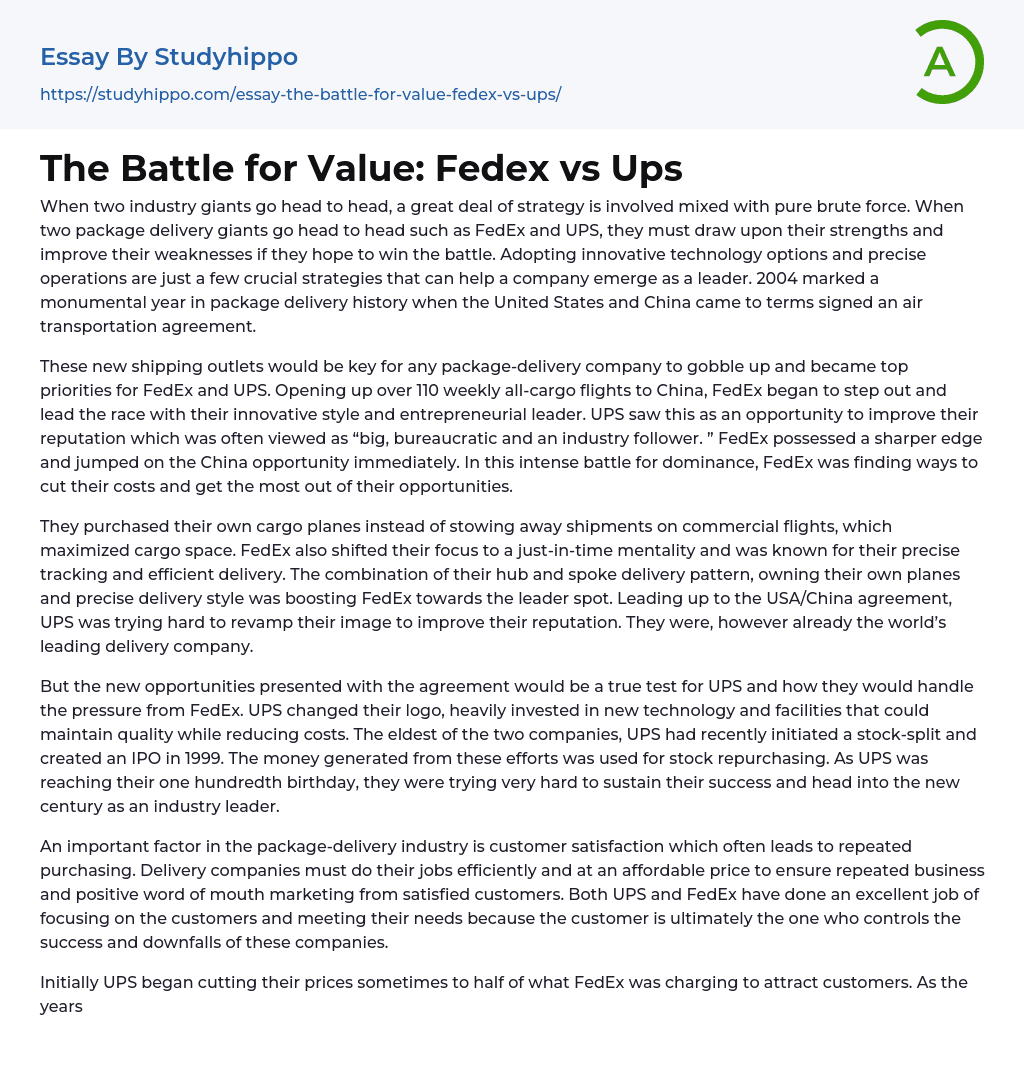When two industry giants go head to head, a great deal of strategy is involved mixed with pure brute force. When two package delivery giants go head to head such as FedEx and UPS, they must draw upon their strengths and improve their weaknesses if they hope to win the battle. Adopting innovative technology options and precise operations are just a few crucial strategies that can help a company emerge as a leader. 2004 marked a monumental year in package delivery history when the United States and China came to terms signed an air transportation agreement.
These new shipping outlets would be key for any package-delivery company to gobble up and became top priorities for FedEx and UPS. Opening up over 110 weekly all-cargo flights to China, FedEx began to step out and lead the race with their innovative style and entrepreneurial le
...ader. UPS saw this as an opportunity to improve their reputation which was often viewed as “big, bureaucratic and an industry follower. ” FedEx possessed a sharper edge and jumped on the China opportunity immediately. In this intense battle for dominance, FedEx was finding ways to cut their costs and get the most out of their opportunities.
They purchased their own cargo planes instead of stowing away shipments on commercial flights, which maximized cargo space. FedEx also shifted their focus to a just-in-time mentality and was known for their precise tracking and efficient delivery. The combination of their hub and spoke delivery pattern, owning their own planes and precise delivery style was boosting FedEx towards the leader spot. Leading up to the USA/China agreement, UPS was trying hard to revamp their image to improve thei
reputation. They were, however already the world’s leading delivery company.
But the new opportunities presented with the agreement would be a true test for UPS and how they would handle the pressure from FedEx. UPS changed their logo, heavily invested in new technology and facilities that could maintain quality while reducing costs. The eldest of the two companies, UPS had recently initiated a stock-split and created an IPO in 1999. The money generated from these efforts was used for stock repurchasing. As UPS was reaching their one hundredth birthday, they were trying very hard to sustain their success and head into the new century as an industry leader.
An important factor in the package-delivery industry is customer satisfaction which often leads to repeated purchasing. Delivery companies must do their jobs efficiently and at an affordable price to ensure repeated business and positive word of mouth marketing from satisfied customers. Both UPS and FedEx have done an excellent job of focusing on the customers and meeting their needs because the customer is ultimately the one who controls the success and downfalls of these companies.
Initially UPS began cutting their prices sometimes to half of what FedEx was charging to attract customers. As the years went on, both companies fell into a reliable and predictable pricing pattern that worked for them. Information technology has also been sought out for competitive advantages to increase efficiency, tracking and reliability. FedEx operates with their COSMOS system and UPS operates on their DIADs system. Both companies are fighting to increase their competitive advantages by grabbing new customers and satisfying existing ones.
To attain a sustainable level of success each business must stick to their core
values while still pushing the limits of technology. The customer seeks out reliability and fair prices. FedEx steps into this situation as the underdog but embraces the role right away by nabbing more flights. UPS enters the situation as the elder company who is working hard to re-vamp their image and improve their operations. Whoever can manage the most flights and sustain their client relationships will see the most success in the future.
- Customer essays
- Customer Satisfaction essays
- Customer Service essays
- Target Market essays
- Advertisement essays
- Advertising essays
- Anheuser-busch essays
- Audience Theory essays
- Brand essays
- Brands essays
- Competitor Analysis essays
- Consumer essays
- Detergent essays
- Marketing Management essays
- Marketing Mix essays
- Marketing Plan essays
- Marketing Research essays
- Marketing Strategy essays
- New Product Development essays
- Point Of Sale essays
- Price essays
- Procurement essays
- Product essays
- Product Differentiation essays
- Product Placement essays
- Promotion essays
- Promotion And Marketing Communications essays
- Research Design essays
- Retailing essays
- Trademark essays
- San francisco essays
- Tennessee essays
- The Us Constitution essays
- U.S. Securities And Exchange Commission essays
- U.S. State essays
- United Parcel Service essays
- United States Postal Service essays
- Attitude essays
- Goals essays
- Personal Goals essays
- Personal Life essays
- Personality essays
- Principles essays
- Reputation essays
- Self Awareness essays
- Self Esteem essays
- Self Reflection essays
- Self Reliance essays
- Strengths essays
- Value essays




